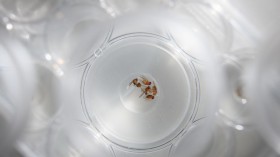Scientists have found the actual cause behind discoloration in Vincent Van Gogh's "Flowers in a Blue Vase" painting.
An international team of researchers led by researcher Koen Janssens from the University of Antwerp, Belgium, has found that the varnish used to protect the painting has caused the bright yellow flowers to change to grayish orange.
Van Gogh, a Dutch artist, painted his "Flowers in a blue vase" in 1887 in Paris, which initially did not have any varnish in the works. But the Kroller-Muller museum, a Dutch institution which is the second museum in the world to have the largest collection of Van Gogh's paintings, had applied a protective varnish on the painting during the early 20th century.
During conservation treatment in 2009, conservators found an "unusual gray opaque crust on parts of the painting with cadmium yellow paint," reported LiveScience. Van Gogh employed cadmium yellow paint, a new pigment used during his time. In unvarnished works, the cadmium yellow loses its color and becomes pale when it gets oxidized with air. Instead the conservators found a gray opaque crust.
"We identified this process a few years ago, and the observation that instead of a slightly off-white, transparent oxidation layer, the pigments in this painting were covered with a dark, cracked crust intrigued us very much," Janssens said in a statement from the European Synchrotron Radiation Facility (ESRF).
In order to find out what had happened, the conservators took microscopic samples of the original paintings and sent them for a study using the powerful X-rays at ESRF in Grenoble, France and the Deutsches Elektronen-Synchrotron DESY in Hamburg, Germany.
They found that a chemical reaction had occurred in the painting at the interface where the paint had combined with the varnish, which formed a compound called cadmium oxalate. Experts also noticed that the sulfate ions in the paint combined with the lead ions from the varnish to form an opaque lead-sulfate compound known as anglesite. Cadmium oxalate and anglesite, together, caused the orange-gray color in the painting.
Researchers are puzzled as to how to remove the varnish above the paint, because when they attempt to remove the varnish, the original yellow paint also comes off. In order to prevent Van Gogh's painting from degradation, Janssens suggested two ways to protect the masterpiece - one is to keep the painting in lower light conditions and the other to use varnish that is more stable than that was used previously, according to the LiveScience report.
The findings of the study are published in Analytical Chemistry.
© 2024 NatureWorldNews.com All rights reserved. Do not reproduce without permission.





